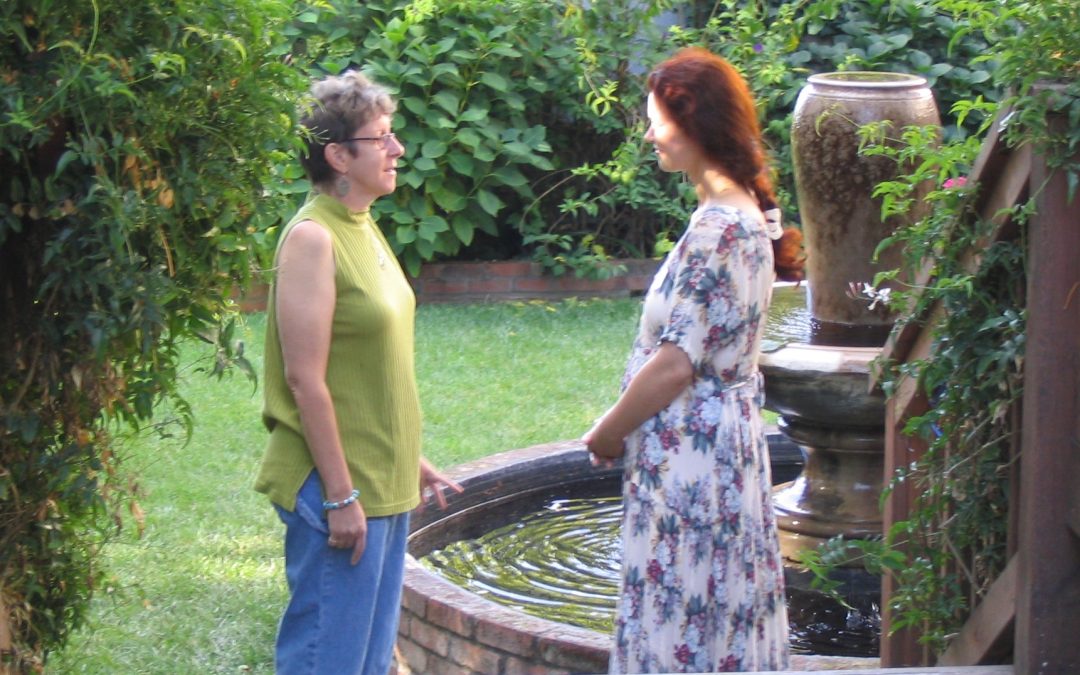Ideally, Stillness Partners are introduced to the modality by another pair of Stillness Partners who are skilled in the practice.
If you are starting the practice without such assistance, our recommendation is for one partner to take responsibility for overseeing and articulating the protocol. We’ll refer to that one as Partner A.
Phase One — Silence
Sit comfortably across from each other so that your knees almost touch.
Close your eyes and breathe slowly and fully.
Imagine your energy and presence dropping down into your belly … then down your legs, through your feet deep into the earth.
Sense the vast stillness of being that is already there, waiting for you.
Sense stillness as the common ground with your partner.
After about a minute, Partner A says, “Let’s gently open our eyes.”
Settle into a gentle mutual gaze devoid of social signals such as smiling or nodding. Instead, just sense your positive regard for this other human being.
Maintain your steady gaze and breathe together for a minute or so.
(No need to make any effort to quiet your mind. Just notice your thoughts without judgment, keep breathing, and direct your focus to the place of shared stillness.)
Practice this gaze together until you can pleasurably enjoy 3 minutes of shared stillness. When you can, you are ready to move to Phase Two.
If you are not ready to move on, let us know what the challenges are and we’ll guide you through it.
Phase Two — Words with no agenda
Take turns, about one-minute each, being listened to in Relational Stillness.
First, close your eyes and drop into the stillness together as before, breathing fully, and take a minute there.
Gently open your eyes and take a full breath together in Relational Stillness.
Partner A says “One minute with [Partner B], starting with a breath, starting now.”
Without compromising the Relational Stillness, Partner B may find words arising. There may be no words. There is no agenda about content, though specific content may thread its way into the turns if that is what is emerging from the stillness without effort.
You may use a timer for this, as long as it vibrates or rings gently or flashes a light so you don’t have to keep looking at it, and the alarm sound isn’t intrusive.
It’s okay not to use a timer if you can sense how long a minute is. It doesn’t have to be exact. The person whose turn it is determines when to end, by saying, “Thank you, [name].” The other says, “Thank you, [name].”
Take a full breath of appreciation together.
Close your eyes and take a full breath back in your own stillness.
The other says, “One minute with [name], starting with a breath, starting now.”
And so on back and forth for at least 3 turns each.
Practice this exercise together until it becomes relaxing and exhilarating. Key to getting there is to allow natural silences, always stopping and dropping into the common ground of stillness. “Ums” and “uhs” and wandering eyes are signs of not being ready to move on to the next phase.
If you are not ready to move on, let us know what the challenges are and we’ll guide you through them.
Phase Three — Agenda
Perhaps the initial set of turns revealed a common issue that calls for clarity, or you have a project or adventure that brought you together in the first place.
Have a brief discussion in Relational Stillness about what thread you want to open up together.
After a full breath with eyes closed and a full breath in Relational Stillness with eyes open, Partner B says “Two minutes with [name], starting with a breath, starting now.”
For this phase you wouldn’t use a timer, just a sense of 2 minutes as determined by the person whose turn it is. Sometimes the turn is longer, sometimes shorter than 2 minutes based on what wants to come through.
You take turns until you get to a place where a discussion wants to break out.
Phase Four — Discussion
You have an actual discussion in relative Relational Stillness, responding though not interrupting. There may be playful repartee, standing, moving. Let it breathe. You may make plans, time lines. We are moving toward how we want to converse in the real world. Where does this take you? Let us know.
Copyright 2013, Lee Glickstein, ReGina Concotelli, and Dr. Julie Hartman. All rights reserved.


